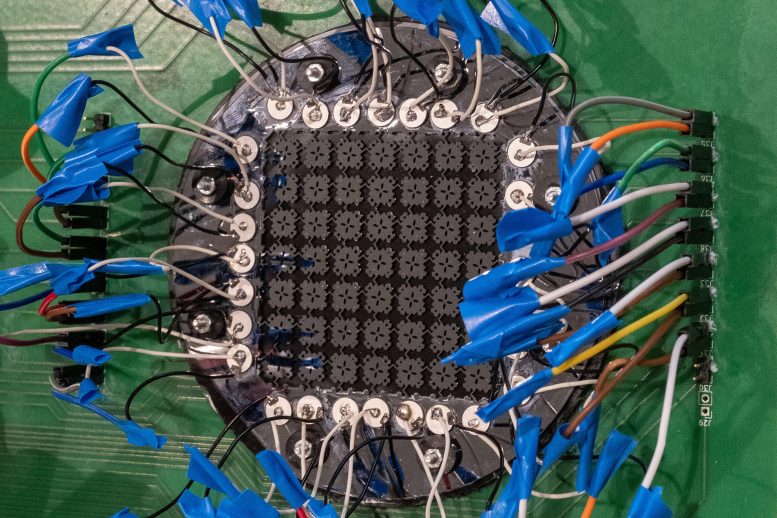
A new mechanical sensor developed by a team led by Marc Serra-Garcia and Johan Robertsson harnesses sound vibrations to power itself, eliminating the need for batteries. This versatile and eco-friendly sensor, made of silicone, can recognize specific sounds for applications in infrastructure, medical devices, and industry. Above is a prototype of the sound sensor. Credit: Astrid Robertsson / ETH Zurich
Sensors used in monitoring infrastructure like bridges and buildings, or in medical devices like prostheses for the hearing impaired, need a continuous power source. Typically, this power is supplied by batteries, which are disposed of and replaced when depleted, leading to a huge waste problem.
An EU study forecasts that in 2025, 78 million batteries will end up in the rubbish every day.
A new type of mechanical sensor, developed by researchers led by Marc Serra-Garcia and ETH geophysics professor Johan Robertsson, could now provide a remedy. Its creators have already applied for a patent for their invention and have now presented the principle in the journal Advanced Functional Materials.
Certain sound waves cause the sensor to vibrate
“The sensor works purely mechanically and doesn’t require an external energy source. It simply utilizes the vibrational energy contained in sound waves,” Robertsson says.
Whenever a certain word is spoken or a particular tone or noise is generated, the sound waves emitted – and only these – cause the sensor to vibrate. This energy is then sufficient to generate a tiny electrical pulse that switches on an electronic device that has been switched off.
The prototype that the researchers developed in Robertsson’s lab at the Switzerland Innovation Park Zurich in Dübendorf has already been patented. It can distinguish between the spoken words “three” and “four.” Because the word “four” has more sound energy that resonates with the sensor compared to the word “three,” it causes the sensor to vibrate, whereas “three” does not. That means the word “four” could switch on a device or trigger further processes. Nothing would happen with “three.”
Newer variants of the sensor should be able to distinguish between up to twelve different words, such as standard machine commands like “on,” “off,” “up,” and “down.” Compared to the palm-sized prototype, the new versions are also much smaller – about the size of a thumbnail – and the researchers are aiming to miniaturize them further.
Metamaterial without problematic substances
The sensor is what is known as a metamaterial: it’s not the material used that gives the sensor its special properties, but rather the structure. “Our sensor consists purely of silicone and contains neither toxic heavy metals nor any rare earths, as conventional electronic sensors do,” Serra-Garcia says.
The sensor comprises dozens of identical or similarly structured plates that are connected to each other via tiny bars. These connecting bars act like springs. The researchers used computer modeling and algorithms to develop the special design of these microstructured plates and work out how to attach them to each other. It is the springs that determine whether or not a particular sound source sets the sensor in motion.
Monitoring infrastructure
Potential use cases for these battery-free sensors include earthquake or building monitoring. They could, for example, register when a building develops a crack that has the right sound or wave energy.
There is also interest in battery-free sensors for monitoring decommissioned oil wells. Gas can escape from leaks in boreholes, producing a characteristic hissing sound. Such a mechanical sensor could detect this hissing and trigger an alarm without constantly consuming electricity – making it far cheaper and requiring much less maintenance.
Sensor for medical implants
Serra-Garcia also sees applications in medical devices, such as cochlear implants. These prostheses for the deaf require a permanent power supply for signal processing from batteries. Their power supply is located behind the ear, where there is no room for large battery packs. That means the wearers of such devices must replace the batteries every twelve hours. The novel sensors could also be used for the continuous measurement of eye pressure. “There isn’t enough space in the eye for a sensor with a battery,” he says.
“There’s a great deal of interest in zero-energy sensors in industry, too,” Serra-Garcia adds. He no longer works at ETH but at AMOLF, a public research institute in the Netherlands, where he and his team are refining the mechanical sensors. Their aim is to launch a solid prototype by 2027. “If we haven’t managed to attract anyone’s interest by then, we might found our own start-up.”
Reference: “In-Sensor Passive Speech Classification with Phononic Metamaterials” by Tena Dubček, Daniel Moreno-Garcia, Thomas Haag, Parisa Omidvar, Henrik R. Thomsen, Theodor S. Becker, Lars Gebraad, Christoph Bärlocher, Fredrik Andersson, Sebastian D. Huber, Dirk-Jan van Manen, Luis Guillermo Villanueva, Johan O.A. Robertsson and Marc Serra-Garcia, 9 January 2024, Advanced Functional Materials.
DOI: 10.1002/adfm.202311877









Be the first to comment on "New Game-Changing Sound-Powered Sensors Could Save Millions of Batteries"